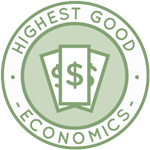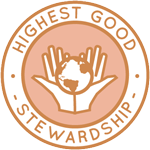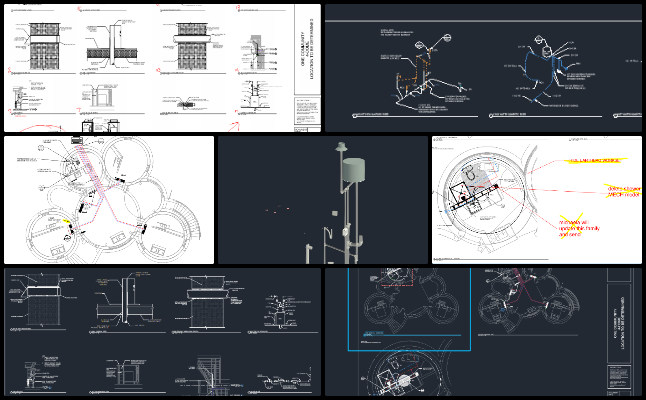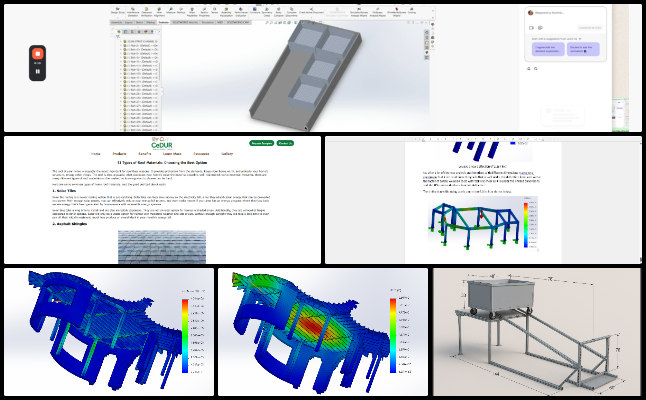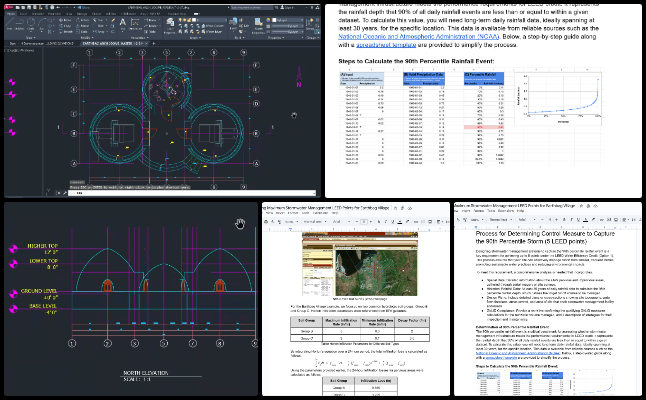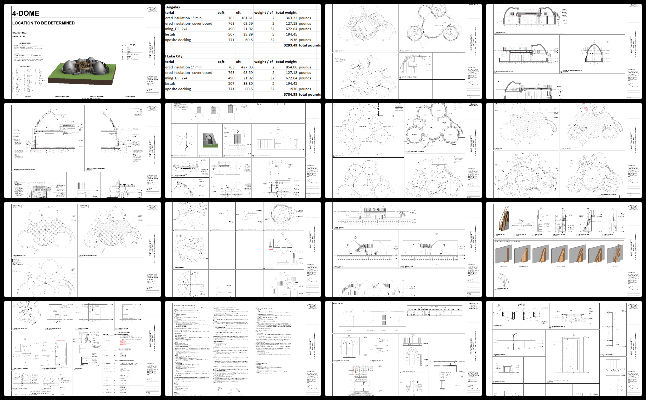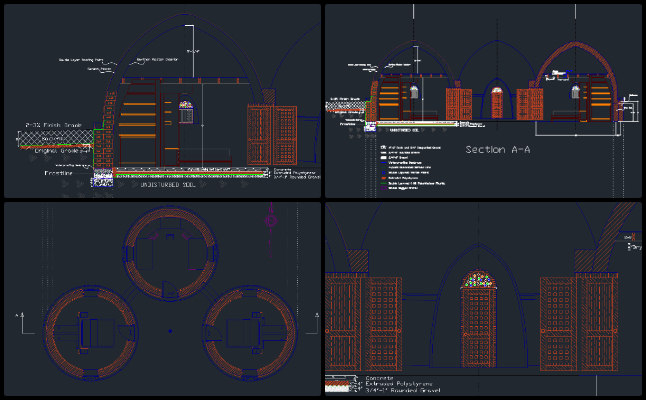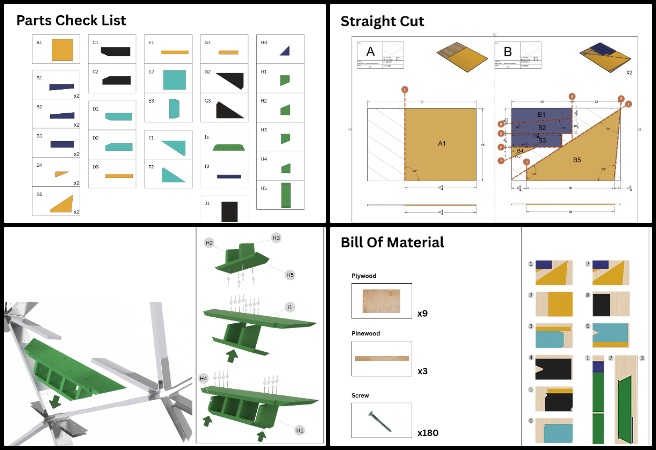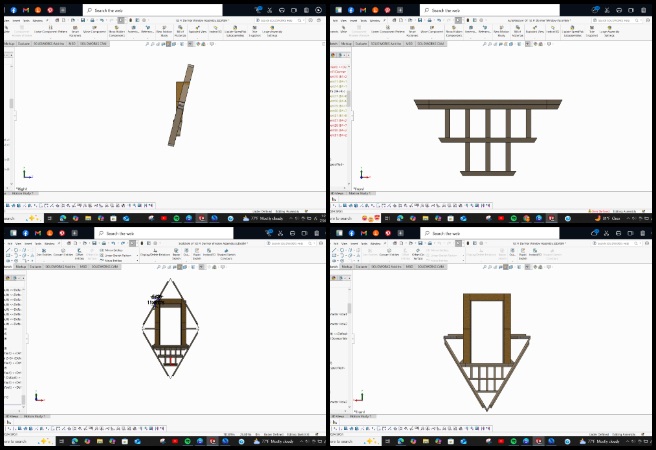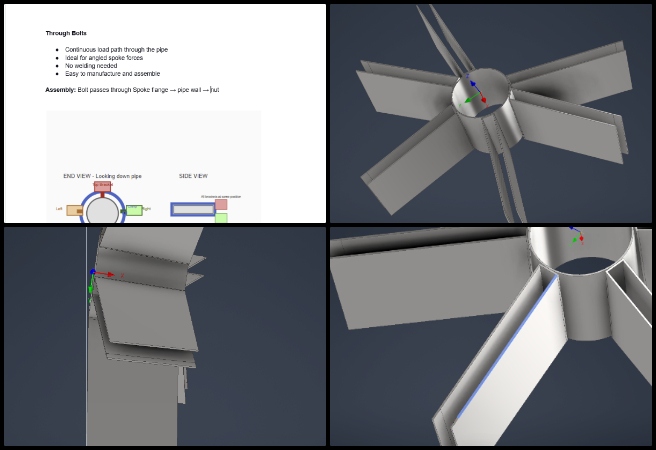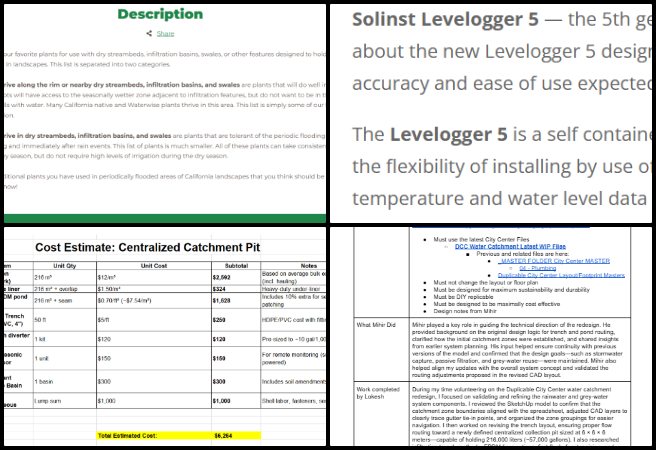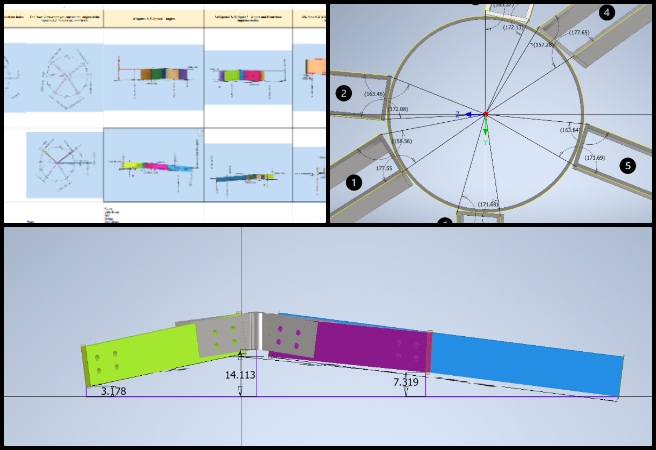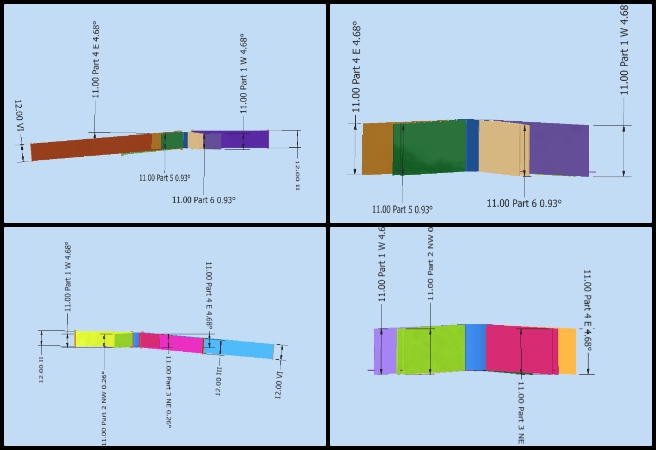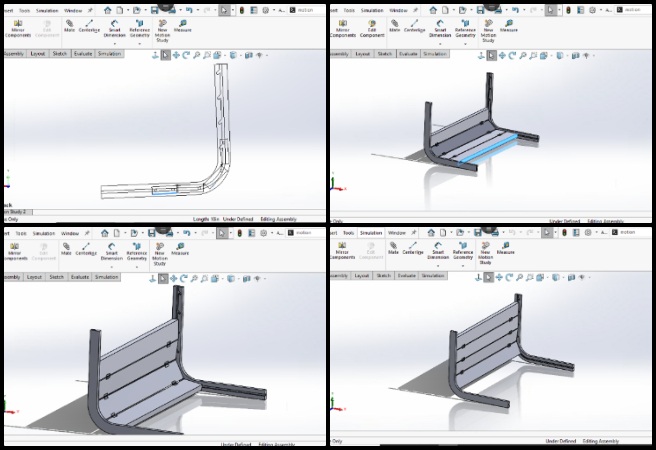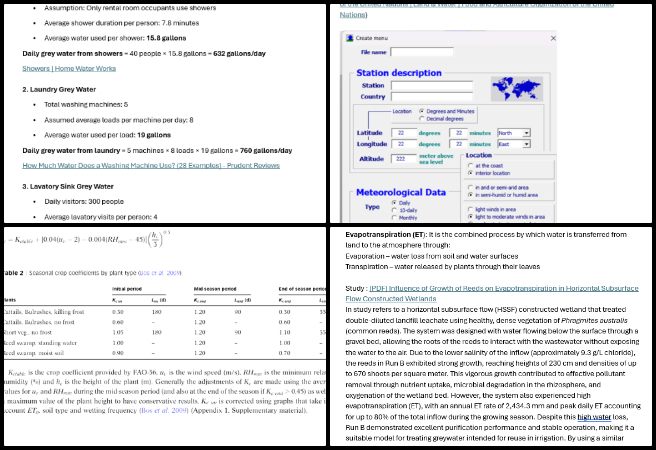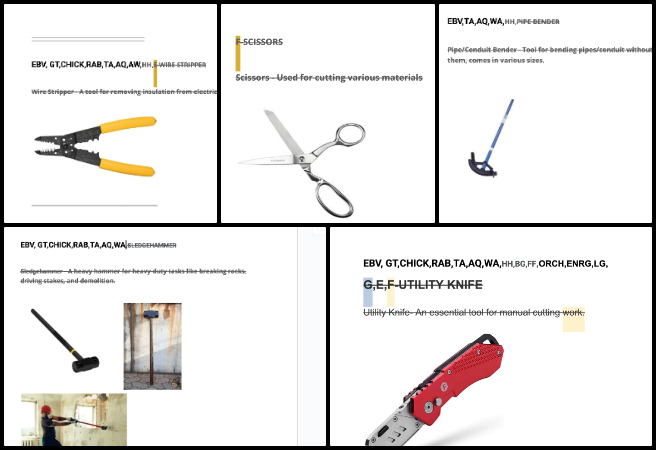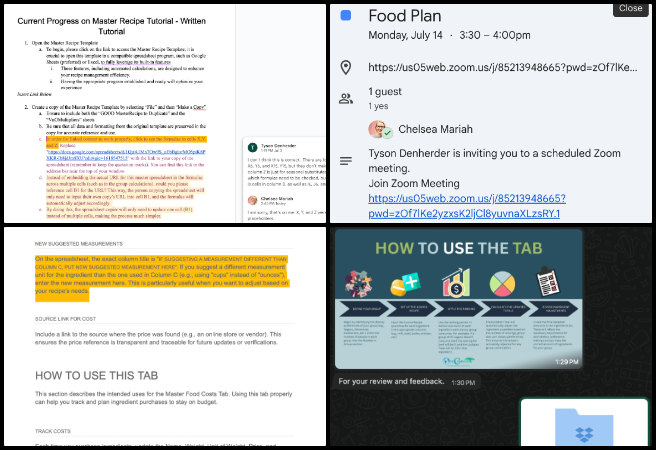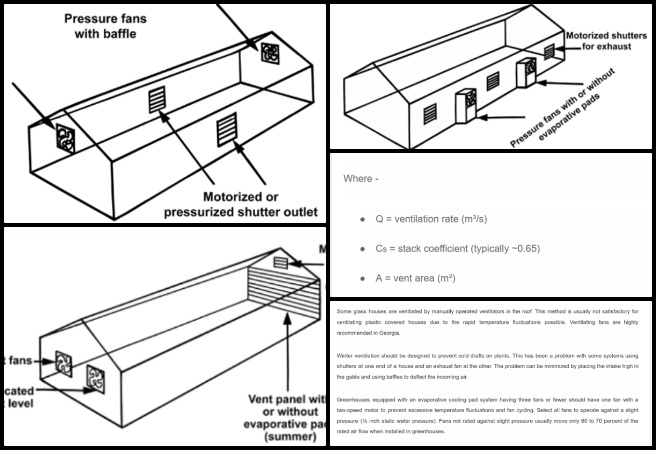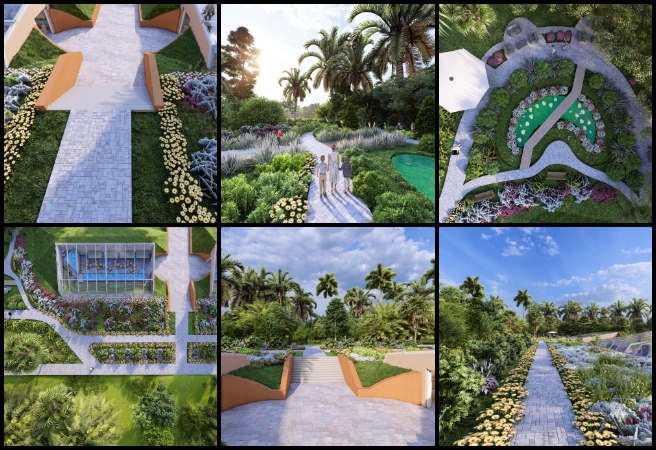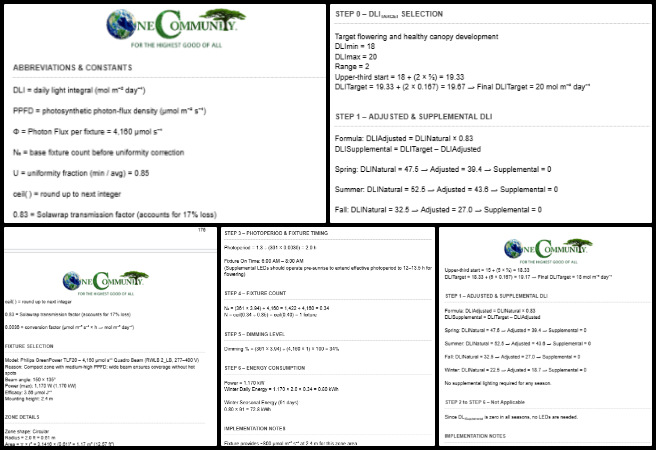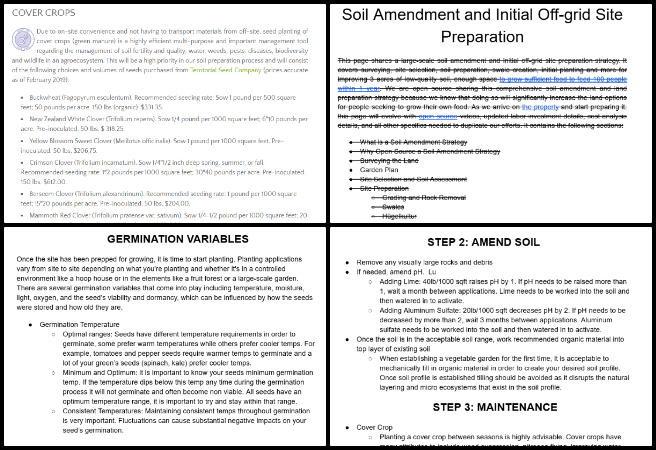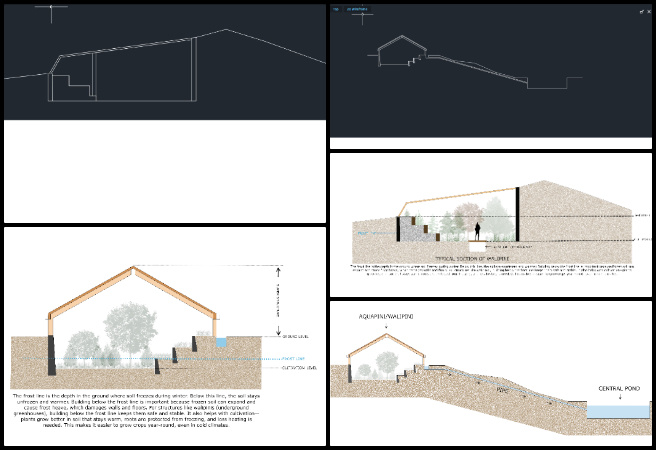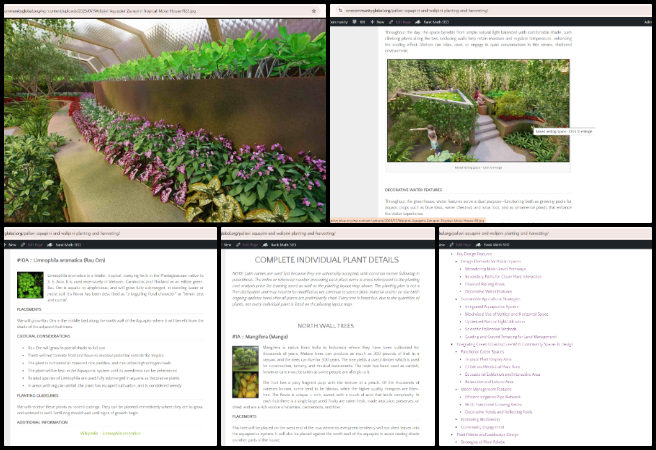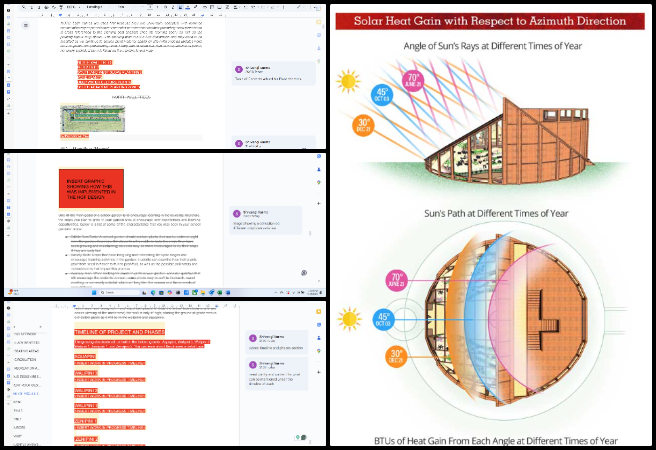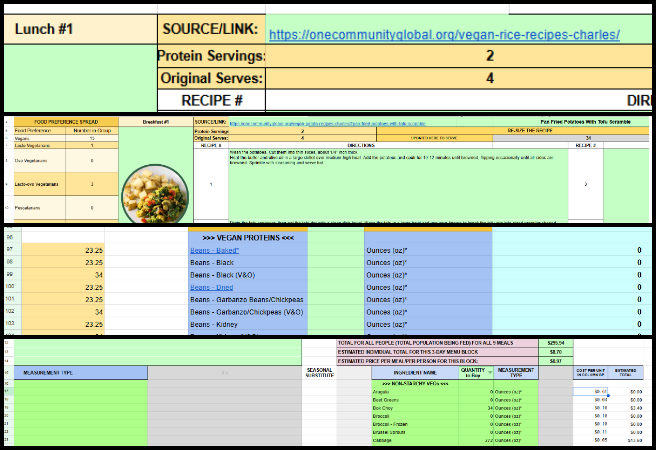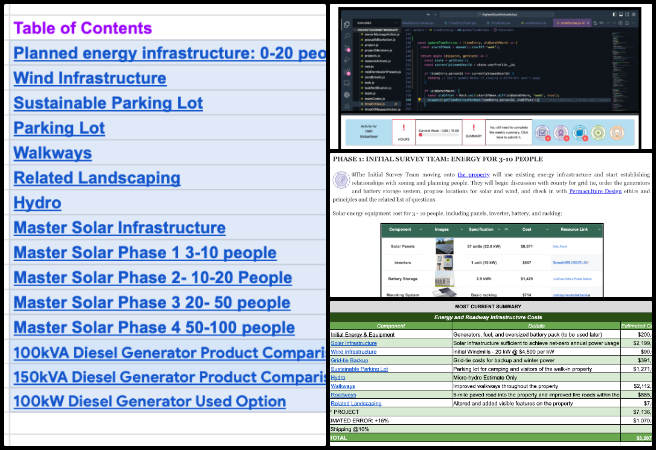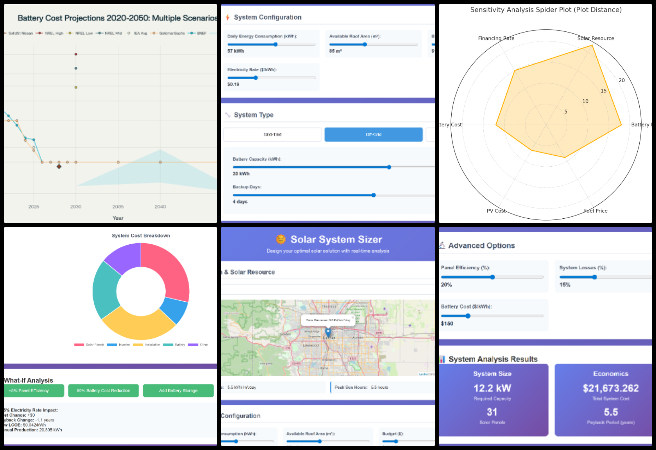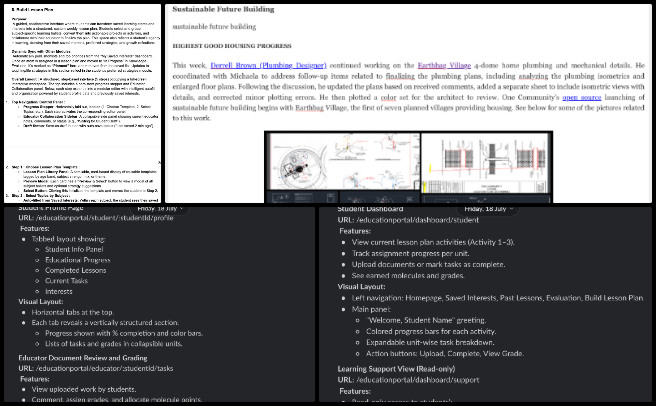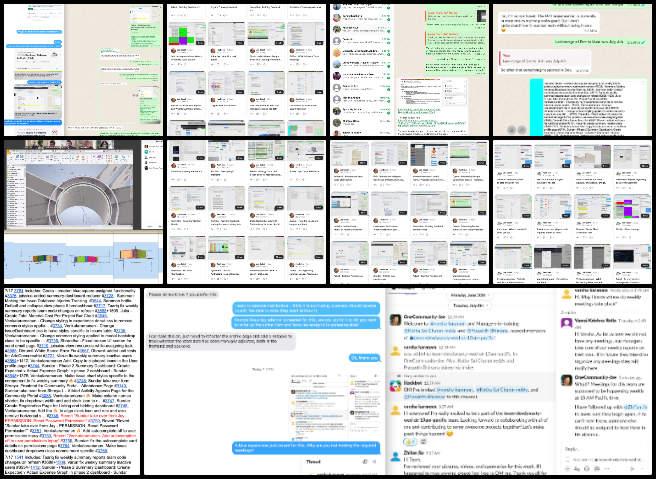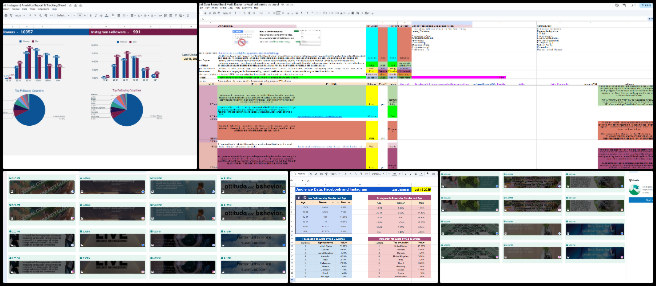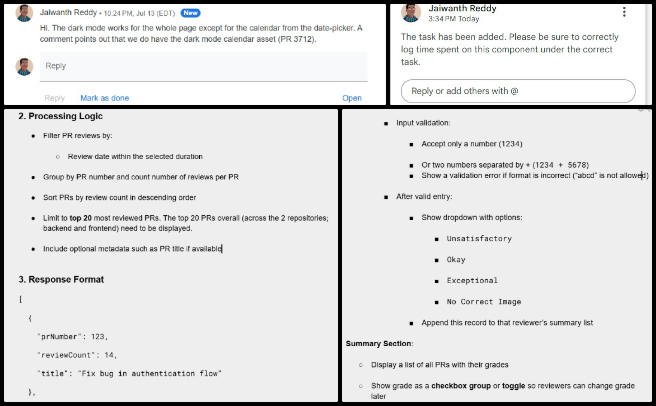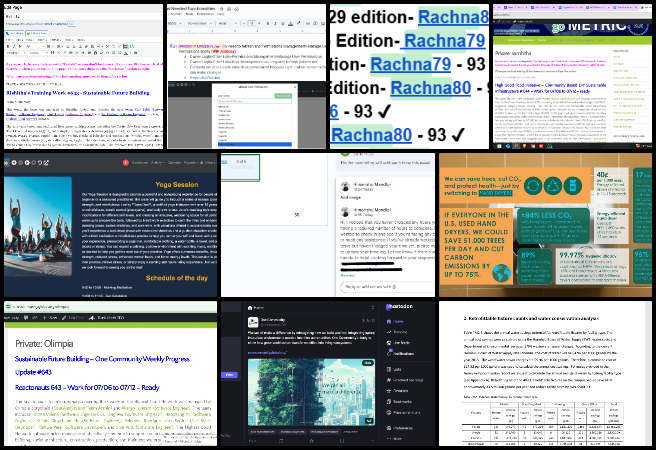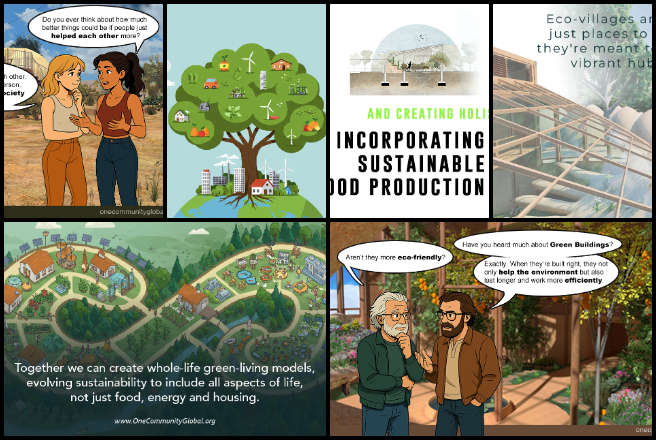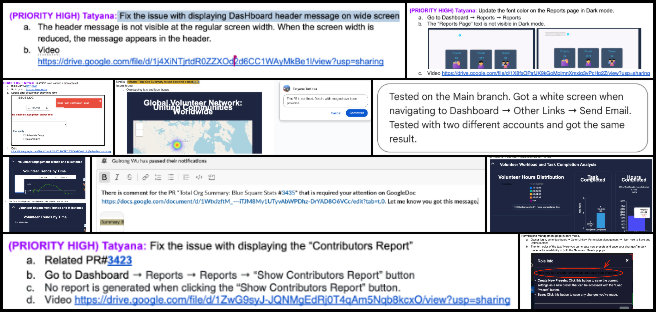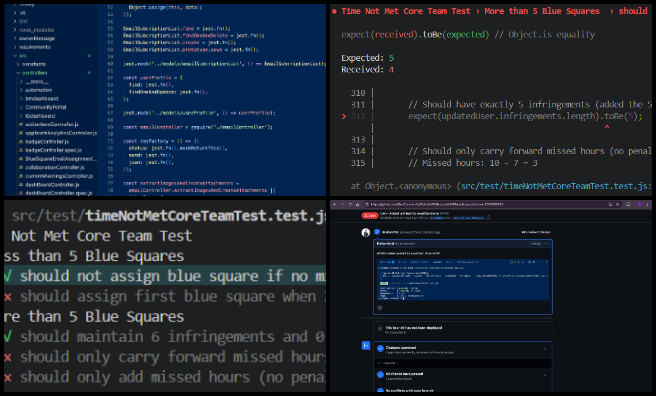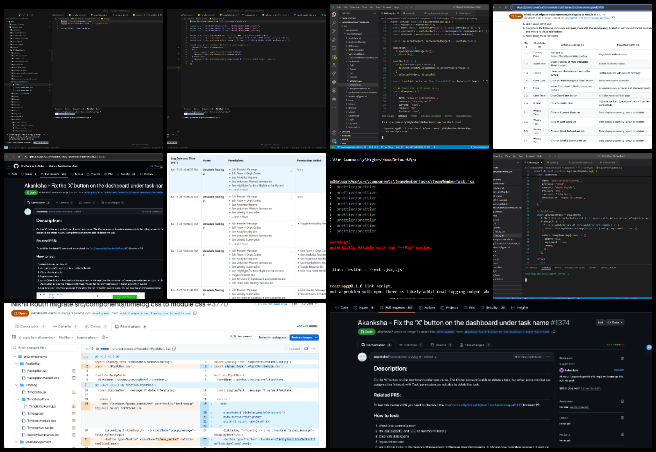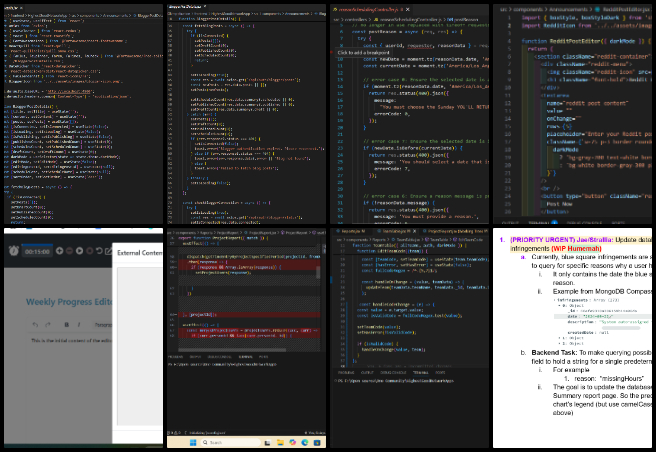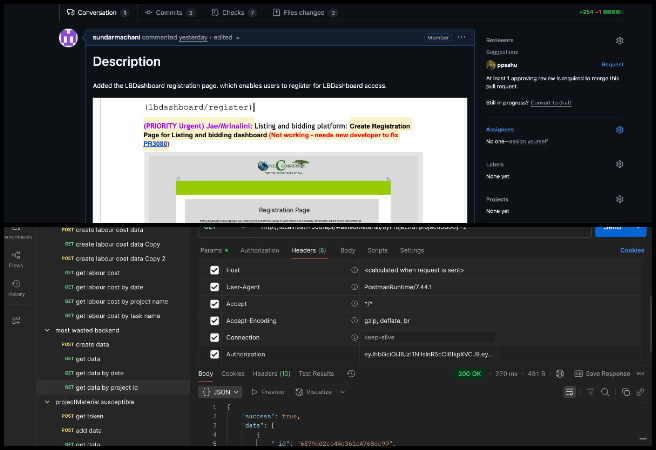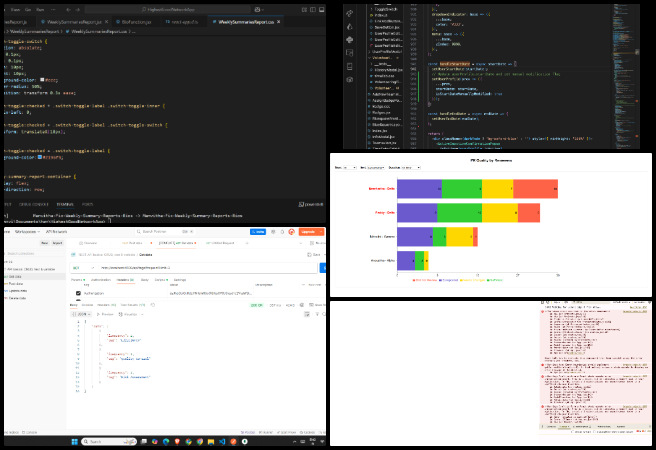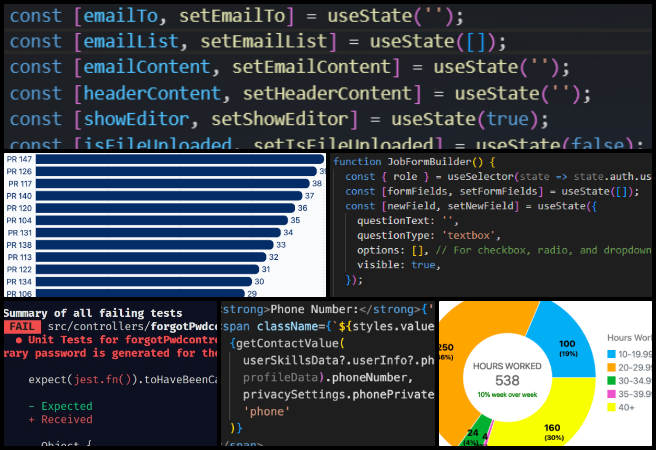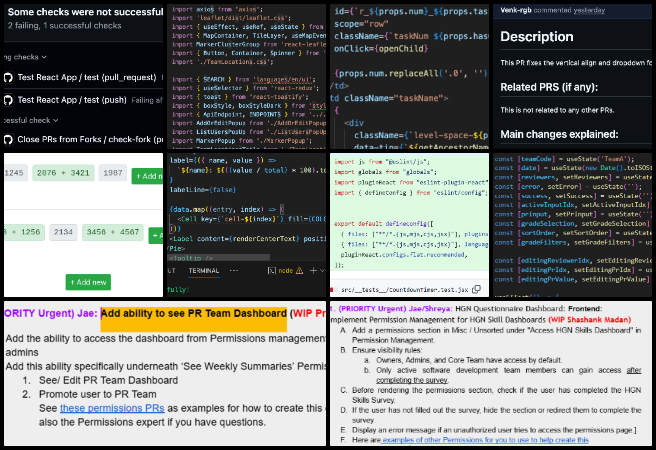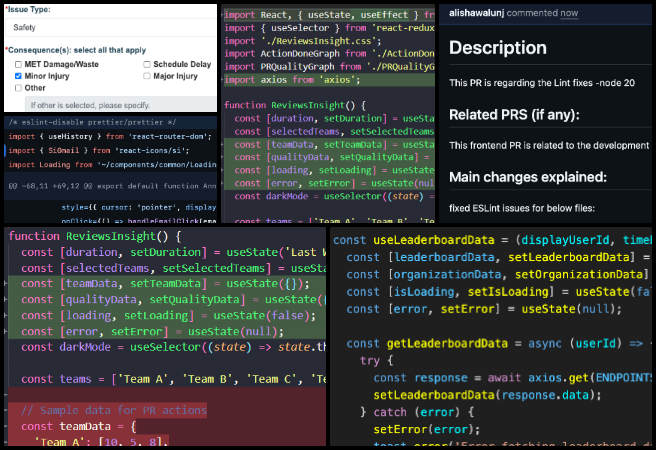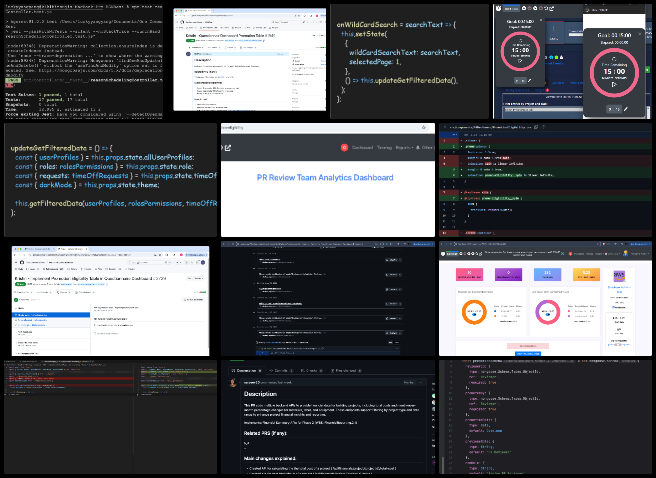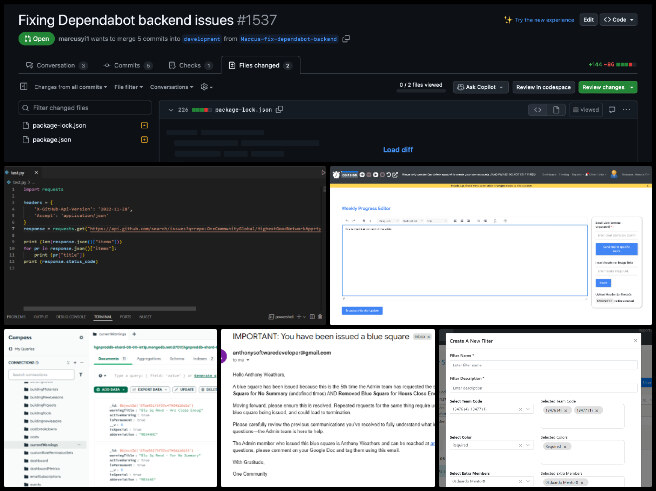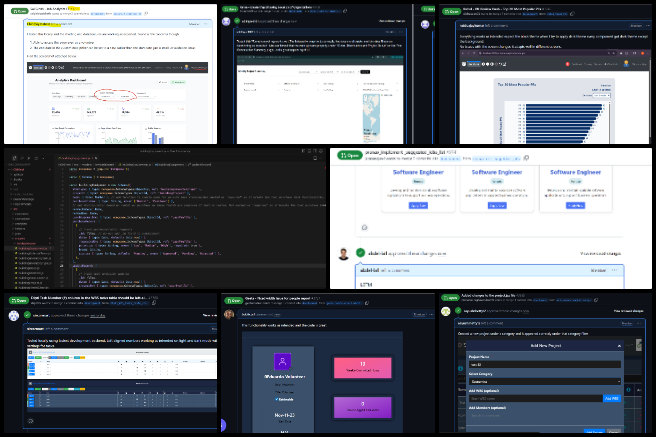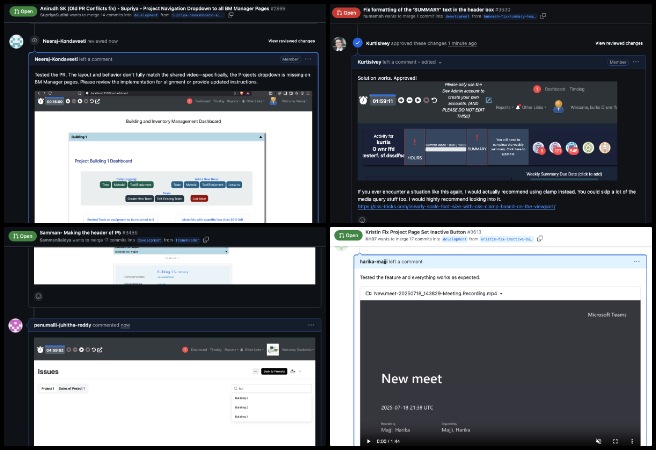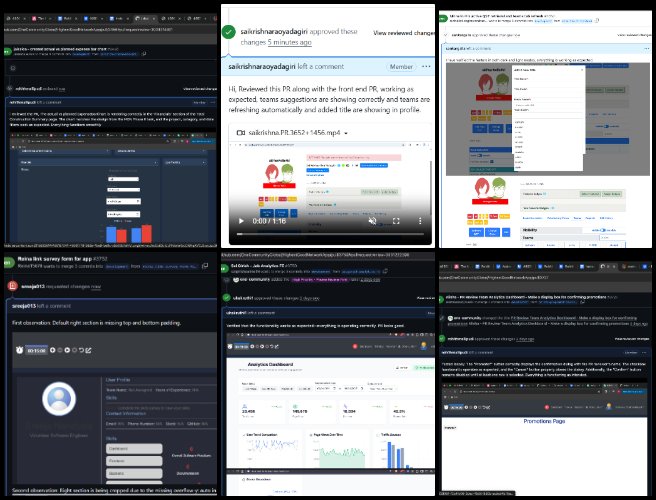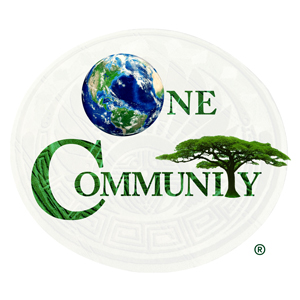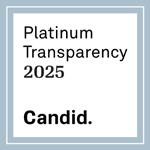Community-based DIY Sustainable Infrastructure – One Community Weekly Progress Update #644
At One Community, we are building community-based, DIY sustainable infrastructure that integrates open source and free-shared solutions for food, energy, housing, education, economics, social architecture, fulfilled living, global stewardship practices, and more. Created by our all-volunteer team, this work is designed to be self-replicating and support a global network of teacher/demonstration hubs. Our goal is to make sustainable living more achievable for everyone while promoting collaboration, innovation, and actions rooted in the values of The Highest Good of All.
- Here’s our project overview
- Here’s our world-change methodology
- Here’s how this becomes self-replicating
- Here’s how we are open source and free-sharing all the do-it-yourself designs
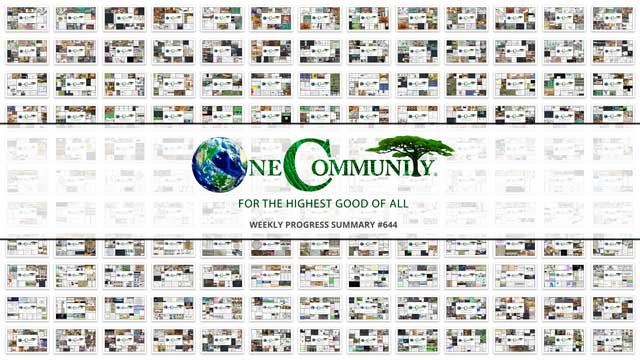
OUR MAIN OPEN SOURCE HUBS
Click on each icon to be taken to the corresponding Highest Good hub page.
One Community’s physical location will forward this movement as the first of many self-replicating teacher/demonstration communities, villages, and cities to be built around the world. This is the July 21st, 2025 edition (#644) of our weekly progress update detailing our team’s development and accomplishments:
Community-based DIY Sustainable Infrastructure
One Community Progress Update #644
DONATE | COLLABORATE | HELP WITH LARGE-SCALE FUNDING
CLICK HERE IF YOU’D LIKE TO RECEIVE AN EMAIL EACH WEEK WHEN WE RELEASE A NEW UPDATE
YOU CAN ALSO JOIN US THROUGH SOCIAL MEDIA
ONE COMMUNITY WEEKLY UPDATE DETAILS
HIGHEST GOOD HOUSING PROGRESS
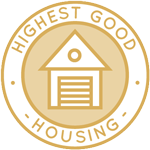 One Community is building community-based DIY sustainable infrastructure through Highest Good housing that is artistic and beautiful, more affordable, more space efficient, lasts longer, DIY buildable, and constructed with healthy and sustainable materials:
One Community is building community-based DIY sustainable infrastructure through Highest Good housing that is artistic and beautiful, more affordable, more space efficient, lasts longer, DIY buildable, and constructed with healthy and sustainable materials:
- Learn about: Our Upcoming Crowdfunding Campaign
- Learn about the different village models: 7 Sustainable Village Models
- Visit the open source portals for the first two: Earthbag Village OS Hub | Straw Bale Village OS Hub
This week, Derrell Brown (Plumbing Designer) continued working on the Earthbag Village 4-dome home plumbing and mechanical details. He coordinated with Michaela to address follow-up items related to finalizing the plumbing plans, including reviewing the plumbing isometrics and associated details. Following the discussion, he updated the plans based on received comments, reorganized the plumbing details to match the architectural sheets, and modified the kitchen framing wall that hosts piping for the fixtures in the dome. He then plotted a colored set of the mechanical and plumbing plans, as well as the electrical plans, for the architect to review. One Community’s open source launching of community-based DIY sustainable infrastructure begins with Earthbag Village, the first of seven planned villages providing housing. See below for some of the pictures related to this work.
Karthik Pillai (Mechanical Engineer) continued working on the Earthbag Village 4-dome cluster roof design by exploring different types of roofing materials to identify viable options ahead of receiving a final decision from Michaela. He assessed what materials might best suit the structural and design needs of the roof layer. Finite Element Analysis was carried out using updated load calculations and an all-wood configuration for the roof structure and found that the resulting deflection was under one inch, indicating that the current configuration may need further adjustment. In parallel, work continued on the Vermiculture Toilet project, with ongoing design revisions focused on improving the waste dumping mechanism to ensure better functionality. Documentation and reports for both the roofing and the vermiculture toilet projects are also being prepared. He noted that the addition of more team members would help in distributing the workload more effectively across tasks. As the first of seven planned villages, the Earthbag Village provides the initial housing within One Community’s open source designs for community-based DIY sustainable infrastructure. See the work in the collage below.
Ketsia Kayembe (Civil Engineer) continued working on editing the AutoCAD excavation drawings for the three domes of the Earthbag Village. She added the required information to the drawings based on the construction template and standards. She also reviewed the LEED content tutorial created by Yi-Ju while waiting to regain access to AutoCAD. Ketsia took note of the necessary components and information to help organize and write content that reflects the updated stormwater management design and its alignment with the LEED evaluation. One Community’s open source framework of community-based DIY sustainable infrastructure begins with Earthbag Village, the first of seven planned villages providing housing. See below for some of the pictures related to this work.
Michaela Silva (Architect) continued working on finalizing the interior of the Earthbag Village. This week, she fine-tuned details in the construction documents and completed both an elevation and plan detail for the electrical outlets and switch framing within the electrical chase, adding them to sheet A504. She also updated the modeled framing in the plumbing wall to optimize space between the shower and sink for plumbing. In addition, Michaela modeled a cold-climate roof insulation assembly to verify structural weight and determined a more accurate value for the tapered insulation. The Earthbag Village is the first of seven villages to be built as part of One Community’s open source model for community-based diy sustainable infrastructure. See her work in the collage below.
Rumi Shah (Civil Engineer) continued working on the Earthbag Village. Work was focused on developing the ADA cluster line type diagram and the elevation section, which involved reviewing layout details and adjusting graphical elements to align with design requirements. The dimension diagram is currently in progress, with measurements and annotations being added to match the corresponding structural and architectural references. One Community’s open source resources for community-based DIY sustainable infrastructure begins with the Earthbag Village, the first of seven planned villages providing housing. See below for some of the pictures related to this work.
DUPLICABLE CITY CENTER PROGRESS
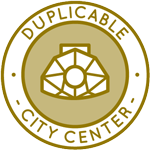 One Community is building community-based DIY sustainable infrastructure through a Duplicable and Sustainable City Center that is LEED Platinum certified/Sustainable, can feed 200 people at a time, provide laundry for over 300 people, is beautiful, spacious, and saves resources, money, and space:
One Community is building community-based DIY sustainable infrastructure through a Duplicable and Sustainable City Center that is LEED Platinum certified/Sustainable, can feed 200 people at a time, provide laundry for over 300 people, is beautiful, spacious, and saves resources, money, and space:
- Learn about this building and it’s function: Duplicable City Center Open Source Hub
This week, Andrew Chen (Industrial Designer) continued work on the Dormer second-floor window for the Duplicable City Center, contributing to the larger goal of community-based DIY sustainable infrastructure, by updating the assembly instruction slides with additional annotations and layout adjustments to improve clarity. He also created the bill of materials and part list, incorporating illustrations and part codes to support the assembly process. See below for the images of the work.
Ariana V. Gutierrez Doria Medina (Industrial Designer) continued developing the dormer windows of the Duplicable City Center. This week, she redrew the parts for the first-floor dormer window, switching the material from pine to plywood to align with the principles of community-based DIY sustainable infrastructure. This change reduced the need for glue, minimized the number of cuts, and simplified construction. As a result, several areas required thickness adjustments. The central structure retained its original thickness despite needing glued joints, and smaller, complex shapes that would have required specialized machinery were eliminated—further reinforcing the project’s commitment to accessible, community-based DIY sustainable infrastructure. See below for images of this work.
Ayushman Dutta (Mechanical Engineer) continued working on reviewing pipe materials for the Duplicable City Center hub connector design. He also researched bolting options for connecting spokes to the pipe and worked on configuring inclined spokes to sit flush with the hub pipe, that directly support the goals of community-based DIY sustainable infrastructure. He documented his findings on these connection methods and developed the spoke design by creating and refining angled configurations, verifying the required angles and dimensions for proper fit and function. Ayushman also collaborated with Nikhil to discuss the design methodology and addressed technical challenges identified during team discussions while making adjustments to ensure integration with the hub connector system. His analysis aimed to optimize performance while considering material availability and structural integrity—key factors in advancing community-based DIY sustainable infrastructure through efficient and scalable design practices. See below for the images of the work.
Lokesh Keshav Mali (Mechanical Engineer) continued focusing on developing the rain- and grey-water system layout for the Duplicable City Center, contributing to the broader mission of community-based DIY sustainable infrastructure. He wrapped up his contributions to the water catchment and greywater system redesign by finalizing the updated downspout sizing and cost sheet, completing a rough cost estimate for the centralized 6×6×6 meter catchment pit, and documenting all updates in a handoff summary. He uploaded the revised CAD layout and Excel files to a shared Dropbox folder, noting the required software version for accessing large CAD files. To support the transition, he created a list of next steps for the incoming team, including greywater routing and trench finalization, and met with Vineela to delegate follow-up tasks and clarify system design details. See below for the images of the work.
Nikhil Bharadwaj (Mechanical Engineer) continued working on creating the spoke designs for the Duplicable City Center hub connector. He collaborated with Nupur and Ayushman to analyze constraints for the hub diameter by evaluating spoke geometry and available pipe dimensions, which led to selecting a 10.7-inch hub diameter. Based on this updated measurement, the modified hub connector and spoke design were finalized. Nikhil documented the design with relevant views, angles, and measurements and created a new spreadsheet to capture the assembly instructions, integrating feedback from the core team and including all necessary details, contributing to the accuracy and reliability essential for community-based DIY sustainable infrastructure initiatives. See below for the images of the work.
Nupur Shah (Mechanical Engineer) continued work on Row 2 of the Duplicable City Center hub connector. This week she added columns to the spreadsheet to better organize part-specific information, including rotation indicators and plane references. She improved document readability by cleaning up the layout and adding clearer images to visualize each component, an essential step in advancing community-based DIY sustainable infrastructure. A new section was introduced to isolate individual parts within Row 2 for easier identification and reference. Additional structure was added to differentiate rotated parts, along with a method to indicate orientation across two planes to support more accurate modeling and communication of part relationships within the assembly, supporting the efficiency and accuracy needed for community Based DIY Sustainable infrastructure initiatives. See below for the images of her work.
Sandesh Kumawat (Mechanical Engineer) continued working on the City Center Natural Pool and Eco-spa Designs. He reviewed the series of folding mechanisms developed over the past month, including the four-bar parallelogram linkage, slot-guided and belt-driven slide-and-fold versions with torsion springs for return, and refined timing-belt pulley arrangements for synchronized and sequential plate movement. He introduced a new concept using flap panels that slide along a curved rail to combine translation and rotation in a single motion. Motion studies confirmed this approach achieved the desired path but introduced added fabrication complexity and alignment issues. Sandesh uploaded all photos and a feedback video to the shared Dropbox folder and, due to the increased intricacy of recent designs, decided to return to the original four-bar linkage layout for its simplicity and reliable horizontal motion, aiding in ongoing community-based DIY sustainable infrastructure design reviews. See below for the images of the work.
Vineela Reddy Pippera Badguna (Mechanical Engineer) continued working on conducted in-depth research on greywater reuse systems as part of ongoing efforts to as part of ongoing efforts to support community-based DIY sustainable infrastructure. She reviewed the final greywater and sewer pipe sizing Excel sheet to determine the number of lavatories, bathtubs, and drinking fountains in the Duplicable City Center. She researched water usage calculators to estimate greywater generation from showers, sinks, and washing machines and explored repurposing this greywater for a pond-based irrigation system. Vineela reviewed the rainwater catchment calculations, cross-checked and updated the catchment zone areas, and examined website options for greywater storage. Additionally, she analyzed how reed growth in constructed wetlands could impact evapotranspiration and researched methods for calculating evapotranspiration rates to evaluate greywater reuse potential for irrigation. See below for the images of the work.
HIGHEST GOOD FOOD PROGRESS
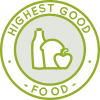 One Community is building community-based DIY sustainable infrastructure through Highest Good food that is more diverse, more nutritious, locally grown and sustainable, and part of our open source botanical garden model to support and share bio-diversity:
One Community is building community-based DIY sustainable infrastructure through Highest Good food that is more diverse, more nutritious, locally grown and sustainable, and part of our open source botanical garden model to support and share bio-diversity:
- Learn about the structures: Hoop House Hub | Aquapini & Walipini Open Source Hub
- See what we’ll be growing: Gardens & Hoop Houses | Large-scale Structures | Food Forest | TA
This week, the core team continued their review of the Master Tools, Equipment, and Materials/Supplies list. Acronyms were added to the specific project lists where the tools, equipment, and materials/supplies will be utilized. Additionally, commas were inserted through page 159 to facilitate the addition of TEMS when searching specific projects. All F and FD acronyms were eliminated. The Highest Good Food initiative is a key component of One Community’s open source plans, focused on community-based DIY sustainable infrastructure, and exemplifies the organization’s commitment through innovative design and implementation. Below are some of the images showcasing this work.
Chelsea Mariah Stellmach (Project Manager) continued her work on the Transition Food Self-sufficiency Plan menus and customization spreadsheets. She met with Tyson to discuss the master recipe spreadsheet and the reports he reviewed, shared Dropbox access information with graphic designer Shireen, and confirmed the plan for the “Current Progress on WBS” document with Jae. She reached out to Tyson regarding some of his proposed changes, watched all relevant Loom videos, and began brainstorming around the user journey map idea suggested by Jae. Chelsea also outlined initial thoughts for creating a user journey map for the master recipe tool. As an essential aspect of One Community’s open source goals, the Highest Good Food initiative supports community-based DIY sustainable infrastructure as a foundation for sustainable living. Below are some of the images showcasing this work.
Dirgh Patel (Volunteer Mechanical Engineer) continued supporting the Climate Battery design evolutions. This week, he enhanced the final report by adding an introduction and explanation to the thermal simulation section, updating the simulation results, and including Fahrenheit equivalents alongside Celsius for better clarity. He revised all eight thermal simulation cases, providing detailed explanations and justifications for when external cooling or heating systems would be needed to maintain optimal greenhouse interior temperatures. To improve ventilation analysis, Dirgh researched greenhouse airflow systems and noted that fans are preferred over manual vents in plastic structures due to rapid temperature fluctuations. He incorporated details about various ventilation systems, including fans in end walls and pressure fans mounted in sidewalls. He also added two types of ventilation rate calculations to the report—covering both natural and mechanical methods—and included the corresponding equations. Additionally, he calculated heat loss and gain due to ventilation and introduced an alternative method using CFM in imperial units. One Community’s open source mission is powerfully reflected in the Highest Good Food initiative, which is dedicated to advancing community-based DIY sustainable infrastructure for global benefit. The following visuals highlight key outcomes of this initiative.
Faeq Abu Alya (Architectural Engineer) continued his work on the Earthbag Village. This week, he updated the Southwest and Southeast regions in Lumion by applying new material settings, updating texture maps, and integrating landscape elements. He added plant models and hardscape components, refined surface finishes and reflectance settings, and configured camera angles to effectively showcase the design from multiple viewpoints. Faeq also reviewed lighting interactions across scenes, making adjustments to ensure consistent visual appearance throughout. As the foundational prototype of One Community’s open source launch of community-based DIY sustainable infrastructure, Earthbag Village represents the first of seven planned villages focused on sustainable housing. The images below highlight this week’s visual progress.
Jay Nair (BIM Designer) continued developing the lighting and HVAC design for the Aquapini and Walipini Planting and Harvesting structures. This week, he refined the lighting energy calculations for the individual zones of Greenhouse Walipini 1 by incorporating zone-specific data such as fixture specifications, usage patterns, and seasonal lighting variations. These updates ensured more accurate energy consumption estimates and were formatted to match the project team’s standardized documentation process. Jay’s contributions directly support the Highest Good Food initiative, a core element of One Community’s open source platform promoting community-based DIY sustainable infrastructure through sustainable and participatory development. The images below show key aspects of this ongoing work.
Keerthi Reddy Gavinolla (Software Developer) continued working on the Highest Good Food page, specifically details for the Soil Amendment page. She made further edits to the Soil Amendment and Initial Off-grid Site Preparation page, refining the document for clarity and completeness. She verified content accuracy by cross-checking updates against the live website to ensure consistency in structure, formatting, and wording. Keerthi also updated Blog #643 for the Moonfall, Expressers, and Lucky Star teams. In addition, she tested several pull requests on the development site to confirm functionality and integration. Built on One Community’s open source foundation, the Highest Good Food initiative supports community-based DIY sustainable infrastructure, empowering communities through accessible, self-sustaining systems. Her contributions are highlighted in the collage below.
Nitin Parate (Architect) continued working on the Highest Good Food initiative, focusing on developing and refining illustrations for the Walipini and Aquapini sections. Instead of extracting sectional views from existing Zenapini files, he created a clean 2D section of the Walipini in AutoCAD, then rendered it in GIMP to better illustrate airflow and water flow concepts. He also researched the concept of the frost line, its relevance to underground construction, and its role in maintaining stable temperatures for year-round cultivation. Nitin began drafting a water inundation management diagram featuring a gravity-fed drainage system directing excess water to a central pond and revised previous Aquapini and Walipini sections based on feedback from Jae to improve clarity in water flow representation and frost line integration. Additional work included exploring a trench design beneath the greenhouse walkway for passive climate control, running thermal simulations, and refining associated structural elements. The Highest Good Food initiative plays a leading role in One Community’s open source platform, promoting community-based DIY sustainable infrastructure through sustainable and participatory development.
Pallavi Deshmukh (Software Engineer) continued adding new Zenapini 2 content to the Aquapini and Walipini Planting and Harvesting page. This included incorporating contributions from Silin, relocating misplaced data to the appropriate section, and thoroughly reviewing all images and hyperlinks before submitting the updates for review. She also revised the full page in response to Jae’s feedback to ensure accuracy and alignment with project standards. In addition, Pallavi created new content for Blog #643 and collaborated with teammates by reviewing their suggestions and integrating feedback to produce a clear and consistent final version. In alignment with One Community’sopen source objectives, the Highest Good Food project integrates community-based DIY sustainable infrastructure into a broader vision of regenerative living. Her contributions are highlighted in the collage below.
Shivangi Varma (Volunteer Architectural Designer And Planner) continued working on the Highest Good Food initiative by working on the completion of both the Aquapini and Walipini Planting and Harvesting page and the Open Source Hub page. Her efforts included adding required content, formatting layouts, proposing key design plans, and integrating additional sections to enhance clarity and usefulness. She also updated the Highest Good Food page based on provided comments, revising images and videos and adding informative captions. The Highest Good Food initiative plays a leading role in One Community’s open source platform, promoting community-based DIY sustainable infrastructure through sustainable and participatory development. The images below highlight her recent contributions.
Tyson Denherder (Volunteer Pioneer Team Member) continued supporting the Highest Good Food initiative by reviewing and providing detailed feedback on the Food Procurement and Storage Overview, the Updated Food Self-Sufficiency Plan Page Report, and the Recipe Build-Out Tool Page Report. He collaborated with Chelsea to evaluate current progress and challenges related to the Recipe Build-Out Tool and its accompanying tutorial. Tyson also advanced development of the tool’s spreadsheet by identifying functional issues, investigating possible causes, and implementing troubleshooting steps. As part of this process, he recorded several explanatory videos to document the problems and propose potential solutions. The Highest Good Food initiative plays a leading role in One Community’s open source platform, promoting community-based DIY sustainable infrastructure through sustainable and participatory development. The images below highlight his contributions to this work.
HIGHEST GOOD ENERGY PROGRESS
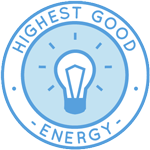 One Community is building community-based DIY sustainable infrastructure through Highest Good energy that is more sustainable, resilient, supports self-sufficiency and includes solar, wind, hydro and more:
One Community is building community-based DIY sustainable infrastructure through Highest Good energy that is more sustainable, resilient, supports self-sufficiency and includes solar, wind, hydro and more:
- Learn about the open source sustainable-energy foundations: Solar, Hydro, and Wind
- Explore our research into the most sustainable products and companies for saving water and energy: Insulation, Eco-laundry, Lightbulbs and Light Bulb Companies, Doors and Door Companies, Windows and Window Companies, Toilets, Faucets and Faucet Accessories, Urinals, and more.
This week, Dishita Jain (Data Analyst) continued supporting with the Highest Good Energy research and cost analysis aimed at empowering individuals to create their own sustainable futures. Her primary focus was on the Energy Infrastructure Cost Analysis and Visualizations project, where she expanded the energy needs sheet by researching total costs associated with hydropower. Dishita consolidated all relevant worksheets into a single master sheet and designated the original sheets as obsolete to streamline data management. She also updated WordPress text and image captions to reflect the most recent project data. Earlier in the week, Dishita gathered detailed information for the energy needs section and consulted with Jae to clarify specific requirements. Additionally, she completed team reviews for both the OC Administration training teams and provided feedback on various administrative tasks. One Community’s open source mission is powerfully embodied in the Highest Good Energy initiative, which advances community-based DIY sustainable infrastructure as a scalable model for global benefit. The images below highlight key aspects of this work.
Shravan Murlidharan (Volunteer Electrical Engineer) continued supporting the Highest Good Energy project by analyzing the economic and environmental benefits of integrating second-life EV batteries into off-grid solar solar microgrid systems for rural applications. He reviewed feedback, refined the report structure, and began drafting the Battery Cost Projections section. With assistance from Perplexity AI, Shravan developed a cost analysis tool featuring visual aids to simplify complex concepts and incorporated key battery parameters. He performed sensitivity assessments to prioritize design factors and built an interactive real-time cost analysis website on GitHub Pages. This platform allows users to adjust inputs like battery capacity and solar panel area to view dynamic cost and environmental impact estimates, presented through charts and graphs with user guidance and accessible design. Through this work, One Community’s Highest Good Energy initiative advances sustainable solutions by promoting community-based DIY sustainable infrastructure. His contributions are showcased in the collage below.
HIGHEST GOOD EDUCATION PROGRESS
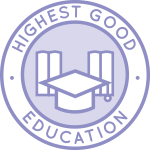 One Community is building community-based DIY sustainable infrastructure through Highest Good education that is for all ages, applicable in any environment, adaptable to individual needs, far exceeds traditional education standards, and more fun for both the teachers and the students. This component of One Community is about 95% complete with only the Open Source School Licensing and Ultimate Classroom construction and assembly details remaining to be finished. With over 8 years of work invested in the process, the sections below are all complete until we move onto the property and continue the development and open sourcing process with teachers and students – a development process that is built directly into the structure of the education program and everything else we’re creating too:
One Community is building community-based DIY sustainable infrastructure through Highest Good education that is for all ages, applicable in any environment, adaptable to individual needs, far exceeds traditional education standards, and more fun for both the teachers and the students. This component of One Community is about 95% complete with only the Open Source School Licensing and Ultimate Classroom construction and assembly details remaining to be finished. With over 8 years of work invested in the process, the sections below are all complete until we move onto the property and continue the development and open sourcing process with teachers and students – a development process that is built directly into the structure of the education program and everything else we’re creating too:
- Program Overview: Education Open Source Hub
- How the components work together in designing human orchestrated eco-abundance: How to use the Education for Life Program
- Lesson Plans for Life – Lesson Plans How-to
- Foundations of Outstanding Leaders, Teachers, and Communicators
- Curriculum for Life
- Teaching Strategies for Life
- Learning Tools and Toys for Life
- Evaluation and Evolution
This week, Harshitha Rayapati (Program Manager) continued work on detailing deliverables for the Highest Good education software platform, outlining various components, developing Figma designs, and expanding the visual layout of the student dashboard. In collaboration with Sphurthy, she prepared Deliverables 1 through 3 to support developer onboarding and ownership. Harshitha added key components and features to synchronize functionality between the student and teacher dashboards, completing the ‘Build a Lesson Plan’ section on both interfaces. She also refined the Highest Good Network Phase 4 document by organizing developer-ready action items and improving access to associated Figma designs. Additionally, Harshitha contributed to the weekly blog update, reviewed the housing team’s progress, edited the blog page, and created a collage. The One Community model of community-based DIY sustainable infrastructure, exemplified by sustainably built classrooms like these, drives sustainable change on a global scale. The collage below highlights her recent contributions.
HIGHEST GOOD SOCIETY PROGRESS
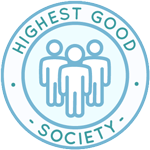 One Community is building community-based DIY sustainable infrastructure through a Highest Good society approach to living that is founded on fulfilled living, the study of meeting human needs, Community, and making a difference in the world:
One Community is building community-based DIY sustainable infrastructure through a Highest Good society approach to living that is founded on fulfilled living, the study of meeting human needs, Community, and making a difference in the world:
- Read the Highest Good society overview: Highest Good Society
- Learn about the model for fulfilled living and sharing: A Day in the Life
- Learn about the 4 economic models: RBE | For-profit | Non-profit | Entrepreneurship
- Learn about our open source community collaboration and management software: The Highest Good Network
This week, the core team completed over 59 hours managing additional volunteer work reviews not listed here, handling emails, overseeing social media accounts, supporting web development, identifying new bugs, integrating bug fixes for the Highest Good Network software, and interviewing and onboarding new volunteer team members. They also produced and incorporated the video above, which illustrates how community-based DIY sustainable infrastructure forms the foundation of One Community’s broader mission. The image below highlights some of this work.
Govind Sajithkumar (Project Manager) continued focusing on analytics and content management for Meta’s Facebook and Instagram platforms. He managed the rotation of content by refreshing feeds with new posts and establishing a consistent posting schedule. To support ongoing analysis, Govind documented content details and metadata in the open source spreadsheet. He also completed the weekly update of social media analytics by collecting and processing audience data for both platforms. In addition, he managed the PR Review Team by providing feedback on team members’ documents, updating the WordPress site with the weekly team summary and collage, and maintaining the PR Review Team Table and HGN PR spreadsheet. Govind reviewed fellow admins’ work and submitted his feedback via the admin feedback table. He finalized his weekly summary and uploaded screenshots of his work to a shared Dropbox folder. These efforts support One Community’s broader mission of community-based DIY sustainable infrastructure. The images below highlight key aspects of this work.
Jaiwanth Reddy Adavalli (Project Manager) continued developing the Job Applicants page along with key components of the Highest Good Network Phase 2 and Phase 4 dashboards, including the PR Team analytics section. He tested multiple pull requests in the Highest Good Network software and progressed on the development of the PR Review Team Analytics dashboard. Jaiwanth updated action items linked to the corresponding Figma wireframes and monitored software team management documents to oversee task creation and follow up on progress. As part of the PR Review Team, he reviewed pull requests submitted by his assigned volunteer team members. This project plays a vital role in One Community’s commitment to community-based DIY sustainable infrastructure. The images below highlight his contributions from this week.
ADMINISTRATION TEAM
The Administration Team summary, managing much of One Community’s ongoing process for community-based DIY sustainable infrastructure, was led by Bhakti Tigdi (Project Manager) and includes Anuneet Kaur (Administrator), Harsha Ramanathan (Administrator), Himanshu Mandloi (Engineering Project Manager), Khushie Zaveri (Communication Strategist), Neeharika Kamireddy (Data Analyst), Olimpia Borgohain (Data Analyst and Team Administrator), Rachna Malav (Data Analyst), Rishi Sundara (Quality Control Engineer and Team Administrator), Rishitha Adepu (Administrator), and Samhitha Are (Administrator). The Highest Good Network software supports managing and objectively measuring this process across social architecture, construction, production, and maintenance.
This week, the Administration Team contributed across content creation, coordination, and technical support. Anuneet focused on sustainability research, volunteer bio updates, and drafting content for the Highest Good Education Program’s Licensing and Accreditation page, along with navigation bar and infographic updates. Harsha researched sustainable toilets and faucets and collaborated with the Graphics team for upcoming visuals. Himanshu managed daily time log reviews, coordinated follow-ups, refined the Admin TimeLog document, and supported weekly content tasks.
Khushie coordinated the social media campaign rollout by finalizing the calendar, preparing promotional assets, and assisting new admin trainees. Neeharika handled task assignments, monitored PR progress, and supported admin training reviews. Olimpia managed LinkedIn content, completed weekly admin tasks, and set up the blog. Rachna monitored pending SEO work and offered support as needed. Rishi tested and reviewed pull requests, merged blogs, and provided training feedback. Rishitha completed admin onboarding, organized Dropbox content, created collages, and finalized training corrections. Samhitha advanced through admin training, edited content, created blogs and images, and participated in a call with Jae—One Community’s team lead—to clarify expectations for future contributions. Collectively, these efforts strengthen One Community’s commitment to community-based DIY sustainable infrastructure. The images below highlight their recent work.
GRAPHIC DESIGN TEAM
The Graphic Design Team, including Yulin Li (Graphic Designer), Qinyi Liu (Graphic Designer), and Rutal Deshmukh (Graphic Designer), focused this week on graphic designs supporting community-based DIY sustainable infrastructure. Qinyi created game-style character designs using MidJourney and ChatGPT, refined them in Photoshop, integrated aligned dialogue into final scenes, and built a website for Gopikalakshmi Asok Kumar based on a template. Rutal developed social media graphics, coordinated feedback with Jae and Sara, and completed updates accordingly. Yulin updated infographics and posters aligned with community-based DIY sustainable infrastructure, managed image versions on Dropbox, and participated in team reviews to finalize content. See the Highest Good Society pages for more on how this contributes to community-based diy sustainable infrastructure. The collage below showcases examples of their work.
HIGHEST GOOD NETWORK PROGRESS
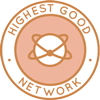 One Community is building community-based DIY sustainable infrastructure through open source Highest Good Network® software that is a web-based application for collaboration, time tracking, and objective data collection. The purpose of the Highest Good Network is to provide software for internal operations and external cooperation. It is being designed for global use in support of the different countries and communities replicating the One Community sustainable village models and related components.
One Community is building community-based DIY sustainable infrastructure through open source Highest Good Network® software that is a web-based application for collaboration, time tracking, and objective data collection. The purpose of the Highest Good Network is to provide software for internal operations and external cooperation. It is being designed for global use in support of the different countries and communities replicating the One Community sustainable village models and related components.
- Learn about our open source community collaboration and management software: The Highest Good Network
This week, the core team continued work on the Highest Good Network pull requests and confirmed the following fixes: pop-up notifications for permission changes (#3396+1336); Dark Mode compatibility and profile picture fallback (#3459); improvements to the “i” icon in Permissions Management (#3163); resolution of white screen issues in Permissions Management (#3482) and on the Other Links → Projects → WBS icon (#3485); and corrected task time updates on the Tasks tab (#3373 ➝ RW3490). This work advances One Community’s focus on community-based DIY sustainable infrastructure.
The following issues were tested but remain unresolved: the Total Org Summary not pulling backend data and having missing charts and overlapping labels (#3478); the issue log form in the bmdashboard (#3197+1242); reports chart UI problems (#3423); a white screen on the Send Emails page at widths of 375px and above (#2426); and volunteer trends by time (#3481). Additionally, the team assigned tasks to five volunteers, left messages on Slack for four others, and reported several new bugs: the issue log form in the bmdashboard (#3197+1242); font color and text alignment problems in the Role “i” icon popup on the Permissions Management page in Dark Mode; display issues in the “Contributors Report”; and header message layout problems on wide-screen dashboards. See the Highest Good Society and Highest Good Network pages for more on how this aligns with One Community’s commitment to community-based DIY sustainable infrastructure. The collage below shows some of this work.
ALPHA SOFTWARE DEVELOPMENT TEAM
The Alpha Software Team, covering their progress on the Highest Good Network software, was managed by Lin Khant Htel (Frontend Software Developer) and includes Nikita Kolla (Full Stack Developer). This software is an internal management and communication platform designed to support community-based DIY sustainable infrastructure.
This week, Lin approved PR #1489, tested it locally with 21 passing test cases, and managed Alpha Team tasks including the review of weekly summaries, photos, and videos aligned with community-based DIY sustainable infrastructure. Nikita reviewed Mongoose testing functions, set up a working base environment, and added tests and sanity checks. See the Highest Good Society and Highest Good Network pages to learn more about how this relates to community-based DIY sustainable infrastructure. The collage below shows some of the team’s work.
BINARY BRIGADE SOFTWARE DEVELOPMENT TEAM
The Binary Brigade Team’s summary, overseeing advancements in the Highest Good Network, was managed by Dishita Jain (Data Analyst) and includes Amalesh Arivanan (Software Engineer), Nikhil Routh (Software Engineer), Ramsundar Konety Govindarajan (Software Engineer), Vamshi Gutha (Full-Stack Developer), and Samman Baidya (Software Engineer). The Highest Good Network software is how we’ll be managing and objectively measuring our progress in community-based DIY sustainable infrastructure through our social architecture, construction, production, and maintenance processes.
Amalesh improved the Permissions Management tracking system by implementing frontend and backend updates, adding auto-refresh, and formatting change logs for better clarity (PR #3777). Nikhil migrated legacy CSS files to CSS Modules, raised PRs #3770 and #3773 for timelog and weekly summaries, and resolved related merge conflicts. Ramsundar investigated a task deletion bug, identified missing permissions, and paused the fix pending clarification. These updates advance One Community’s goal for community-based DIY sustainable infrastructure.
Samman progressed the Tool/Equipment Phase II backend by adding projectID filtering, building a GET API, and resolving bugs and conflicts from older PRs. Vamshi developed the frontend of the Phase 2 Summary Dashboard with interactive charts showing injury trends, filters by project and date, and real-time updates. See the Highest Good Society and Highest Good Network pages for more on how this work supports community-based DIY sustainable infrastructure. The collage below shows examples of their contributions.
BLUE STEEL SOFTWARE DEVELOPMENT TEAM
The Blue Steel Team’s summary, presenting their work on the Highest Good Network software, was managed by Sheetal Mangate (Software Engineer) and includes Humemah Khalid (Software Engineer/Backend Developer), Linh Huynh (Software Engineer), and Ramakrishna Aruva (Software Engineer). The Highest Good Network software is how we’ll be managing and objectively measuring our process for community-based DIY sustainable infrastructure.
Linh worked on the Blogger auto-poster feature and investigated the merge conflict between PR #3527 and PR #1390 by reviewing code, file structures, and logic. He updated Rishi and Himanshu on the status and confirmed that both pull requests were still under review. Ramakrishna analyzed how lost hours connect to projects and individuals, identified logic improvements, and began drafting backend and frontend updates. He also reviewed how roles and project types impact data visibility. Both team members contributed significantly to One Community’s vision for community-based DIY sustainable infrastructure.
Humemah began adding structured reasons to blue square infringements by creating a new database field and updating the backend to include them automatically or manually. He also completed the weekly summary and uploaded images. Sheetal implemented OAuth for Reddit authentication, updated the front and backend flow for secure token exchange, and created a UI for Reddit post submissions. This collective effort advances One Community’s goal of community-based DIY sustainable infrastructure. See the Highest Good Society and Highest Good Network pages for more, and the collage below for images of their work.
CODE CRAFTERS SOFTWARE DEVELOPMENT TEAM
The Code Crafters Team, covering their work on the Highest Good Network software, was managed by Sai Moola (Software Engineer) and includes Ashrita Cherlapally (Software Engineer), Greeshma Palanki (Software Engineer), Humera Naaz (MERN developer), Pratyush Prasanna Sahu (Software Engineer), Ravi Kumar Sripathi (Software Engineer), and Sundar Machani (Software Engineer). The Highest Good Network software is how we’ll manage and objectively measure our process for establishing community-based DIY sustainable infrastructure through our social architecture, construction, production, and maintenance processes.
Ashrita integrated a backend endpoint with the frontend map application, troubleshooting a rendering issue with the GeoJSON layer. Greeshma resolved a blank page error in PR #2196 related to undefined timeEntryEditHistory for inactive users, and fixed a Node.js version conflict. Humera worked on PR #735, debugging local development issues related to permission handling and controller logic. Pratyush completed the backend for the Most Wasted Material task, adding endpoints to filter records by project and date, and tested the behavior using Postman. These efforts enhance features critical to community-based DIY sustainable infrastructure.
Ravi designed Figma layouts for the Past Lesson Plans and Growth Portfolio, incorporating reflection prompts and ratings aligned with resource reuse and participatory planning. Sai worked on Job Posting Page Analytics, rendering a horizontal bar chart and beginning backend development with a new schema and controller. Sundar resolved merge conflicts and test failures across multiple PRs, fixed a white screen issue on the construction summary page, and implemented a frontend fix for the Listing and Bidding Registration page. He also began outlining backend upgrades to scale support for community-based DIY sustainable infrastructure. See the Highest Good Society and Highest Good Network pages for more on how this relates to community-based DIY sustainable infrastructure. View some of the team’s work in the collage below.
DEV DYNASTY SOFTWARE DEVELOPMENT TEAM
The Dev Dynasty Team’s summary, covering their work on the Highest Good Network software, was managed by Zhifan Jia (Software Engineer) and includes Deekshith Kumar Singirikonda (Developer), Dharmik Patel (Software Engineer), Manvitha Yeeli (Software Engineer), Mohan Satya Ram Sara (Software Engineer), Prasanth Bhimana (Software Engineer), Saicharan Reddy Kotha (Software Engineer), Shraddha Shahari (Software Engineer), Vamsi Krishna Rolla (Software Engineer), and Varsha Karanam (Software Engineer). The software helps manage and measure our community systems—including social architecture, construction, and maintenance—and supports eco-lifestyle access globally. This contribution strengthens One Community’s focus on community-based DIY sustainable infrastructure.
This week, Deekshith built a secure and testable user registration system using Node.js, Express, and bcrypt, complete with validations and unit tests. Dharmik resolved backend build failures and fixed environment variables, improving stability for scalable backend systems. Manvitha improved the Weekly Summaries Report page filters and aligned their design with Figma. Mohan fixed timezone-related bugs and theme inconsistencies and added tests to improve UI reliability. Prasanth began Phase 2 work by validating frontend/backend functionality and reporting broken features using dummy data.
Saicharan tested key Phase 2 features like Expense Graphs and Loss Tracking, providing feedback and documenting results. Shraddha implemented responsive dark mode styling for PRs 2891 and 3612. Vamsi completed testing of Phase 2 graphs and ensured proper responsiveness and accessibility. Varsha reviewed PRs, optimized UI clarity, and organized documentation. Zhifan hosted the stand-up meeting and finalized a pull request correcting user start dates to further support community-based DIY sustainable infrastructure. See the Highest Good Society and Highest Good Network pages for more on how this relates to community-based DIY sustainable infrastructure. View some of the team’s work in the collage below.
EXPRESSERS SOFTWARE DEVELOPMENT TEAM
The Expressers Team’s summary, which covers their work on the Highest Good Network, was managed by Strallia Chao (Software Engineer) and includes Casstiel Pi (Software Engineer), Meenashi Jeyanthinatha (Full Stack Developer), Rahul Trivedi (Software Engineer), Reina Takahara (Software Developer), and Tanmay Arora (Software Engineer). The Highest Good Network software helps us manage and objectively measure our progress toward community-based DIY sustainable infrastructure through innovative software development, testing, and collaboration.
This week, Casstiel researched the Plurk API and began implementing the UI for the auto-poster feature. He added a textarea for composing posts, managed input with new state variables, and used Axios to send data to the backend. Toast notifications were added for success and error feedback, maintaining logic consistent with the existing editor structure. Backend research to support frontend functionality is ongoing. Meenashi modified the volunteer role basicInfo page to fetch user data by userId instead of all users, resolved a test case failure, and addressed ESLint errors triggered during a backend release. After rolling back and fixing commit issues blocked by protected method changes, she successfully pushed changes using the command git commit –no-verify. This project supports One Community’s aim for community-based DIY sustainable infrastructure.
Rahul completed and submitted PR 3746 for the Top 20 PRs graph, including a video and setup instructions. He began adding dark mode support and improved mock datasets based on feedback. Reina submitted PR 3752 for survey form data integration on the skills page and revised PRs 3432 and 3458 for the organization map and cost breakdown graph, respectively, resolving all feedback, lint issues, and testing concerns across these PRs. Strallia coordinated progress on the Volunteer Hours Distribution chart, updating the legend and styles to match the Figma design using backend data, added hover tooltips, and submitted PR 3776. She also updated the Bugs document for blue square infringement reasons. Tanmay implemented a referral link generator for job ads using slugify for URL formatting, updated the UI to allow link copying, and resolved module import and dependency issues, improving referral tracking and user experience. See the Highest Good Society and Highest Good Network pages for more on how this contributed to community-based diy sustainable infrastructure. See the collage below to view the team’s work.
LUCKY STAR SOFTWARE DEVELOPMENT TEAM
The Lucky Star Team’s summary, which covers their work on the Highest Good Network, was managed by Barnaboss Puli (Volunteer Software Engineer) and includes contributions from Dipti Yadav (Software Engineer), Durga Venkata Praveen Boppana (Software Engineer), Ganesh Karnati (Software Engineer), Kedarnath Ravi Shankar Gubbi (Software Engineer), Manoj Gembali (Software Engineer), Pranav Govindaswamy (Software Developer), Shashank Madan (Software Engineer), Veda Bellam (Software Engineer), and Venkataramanan Venkateswaran (Software Engineer). Their work continued to support our goal of community-based DIY sustainable infrastructure through collaborative and cross-functional software development.
This week, Barnaboss created a reusable, searchable, sortable, and debounced table for the HGN Phase 2 “Fix Project Details” task. He enhanced backend queries with dynamic filters, tested with Postman, and developed the /bmdashboard/lessons/add page using React Hook Form with auto-tagging for project names. Dipti addressed two UI issues: aligning the “Task Number (#)” column in the WBS tasks table and investigating a persistent layout problem with a red circular icon—still under review. Durga resolved linting errors for Node.js version 20, submitted PR #3769, and began implementing XSS protection in the ReviewButton component. Ganesh refined the Weekly PR Grading UI, adding inline grading, delete confirmation, styling, filtering, validation, and keyboard shortcuts, concluding with thorough testing. Kedarnath supported the Node upgrade by fixing lint errors, resolving merge conflicts, and assisting with local setup fixes.
Manoj developed the frontend for the PR Grading Screen, creating routes, styling tables, and implementing PR number validation for various formats. Pranav introduced permission-based access controls to the PR Team Dashboard, adding new permissions, UI elements like the “Promote to PR Team” button, and updating Redux logic with an accompanying walkthrough video. Shashank enhanced the HGN Questionnaire Dashboard by adding permission-based survey visibility, fixing backend bugs, and submitting related PRs. Veda created a donut chart for the Job Posting Page Analytics feature, refined UI labels, and implemented backend aggregation queries using MongoDB, testing with dummy data while seeking clarification on data sources. Venkataramanan submitted ten frontend and backend PRs, addressing bugs, improving UI consistency, and enhancing platform stability. See the Highest Good Society and Highest Good Network pages to learn more about how this work supports community-based DIY sustainable infrastructure. See the collage below to view the team’s work.
MOONFALL SOFTWARE DEVELOPMENT TEAM
The Moonfall Team’s summary, covering their work on the Highest Good Network, was managed by Shashank Kumar (Software Engineer) and includes Alisha Walunj (Software Engineer), and Bhavpreet Singh (Software Engineer). The Highest Good Network software enables us to manage and objectively measure progress toward community-based DIY sustainable infrastructure through innovative software development, testing, and collaboration.
This week, Alisha built a pie chart for the Job Posting Page Analytics task to display applicant reasons for volunteering. She resolved Netlify build issues in PR 3727 for the Review Team Analytics Dashboard by adding a display box and fixing routing conflicts. Additionally, she completed the Lintfix-node-20 task by addressing issues in 17 files, submitting PR 3783. Bhavpreet connected the PR Analytics Reviews Insights frontend with the backend, made structural backend changes, and implemented a POST request to insert test data. He also updated frontend actions, reducers, and constants to properly process and display the data. Shashank optimized API calls by modifying frontend actions and reducers and introduced lazy loading to reduce network load. He investigated a bug in the BM Dashboard, identifying missing logic and UI flow inconsistencies, and is planning a rewrite to resolve the issue next week. See the Highest Good Society and Highest Good Network pages for more details on how this work supports community-based DIY sustainable infrastructure. The collage below showcases the team’s work.
REACTONAUTS SOFTWARE DEVELOPMENT TEAM
The Reactonauts Team’s summary, covering their work on the Highest Good Network was managed by Olimpia Borgohain (Data Analyst and Team Admin) and Akshay Jayaram (Software Engineer). The team includes Fatima Villena (Software Engineer), Ghazi Rahman Shaik (Software Engineer Intern), Guirong Wu (Software Engineer), Jaydeep Mulani (Software Developer), Kristin Dingchuan Hu (Software Engineer), Peterson Rodrigues dos Santos (Full Stack Developer), Rishwa Patel (Software Developer), and Siva Putti (Software Engineer). The Highest Good Network software helps manage and objectively continue to support by focusing on community-based DIY sustainable infrastructure, social architecture, construction, production, and maintenance processes to build sustainable and thriving ecosystems. This solution is portable, scalable, and ideal for off-grid or sustainable living communities.
This week, Akshay adjusted CSS breakpoints to improve the responsive behavior of the profile component, ensuring it remains on the right side until smaller screen widths, updated media queries, and communicated these changes to the team. He assisted Jaydeep with onboarding by answering development workflow questions, began a new task in PeopleReports, tracked daily pull requests, and submitted the Reactonauts team’s weekly review. Fatima resolved lint issues in the update node version branch, renamed CSS classes to avoid generic names, and continued developing the table supporting the Promotion Eligibility feature. Ghazi refactored the TagsSearch and AddTaskModal components to use a preloaded dataset instead of live search, added input focus suggestions, excluded already-assigned users, fixed data structure inconsistencies and a failing test blocking merges, and resolved merge conflicts related to the default password PR. Guirong addressed review comments on the task creator mouseover feature and investigated backend integration test failures caused by missing MongoDB configuration in GitHub Actions.
Jaydeep reviewed bug and workflow documentation, estimated time for key email-related tasks, restored Weekly Summaries Report email functionality, planned safe email testing using custom recipients, and implemented a new endpoint with recipient customization support in the BlueSquare controller. Kristin completed backend implementation for the Promotion Table on the PR Review Dashboard by renaming a router file to fix an API 404 error, added reviewForThisWeek and processPromotion functions, opened backend PR1549, and fixed issues in frontend PR3729. Peterson fixed a User Management page bug that prevented table updates when filters were applied. Rishwa developed backend and frontend components for the PR Review Team Analytics Dashboard, including new API endpoints, controller logic, schema updates, frontend data display components, fixed a backend aggregation error, and outlined integration of a promotion eligibility model. Siva fixed missing visuals of assigned versus completed tasks in the Total Organization Summary dashboard, implemented “Create New Team” task changes under Team Management, and restricted the “Delete Task” option based on user permissions. These efforts support One Community’s commitment to community-based DIY sustainable infrastructure. See below for a snapshot of the team’s work.
SKYE SOFTWARE DEVELOPMENT TEAM
Skye Team’s summary, covering their work on the Highest Good Network was managed by Olimpia Borgohain (Data Analyst and Team Admin) and Anthony Weathers (Software Engineer). The team includes Julia Ha (Software Engineer) and Marcus Yi (Software Engineer). The Highest Good Network software helps manage and objectively continue to support by focusing on community-based DIY sustainable infrastructure, construction, production, and maintenance processes to build sustainable and thriving ecosystems. This solution is portable, scalable, and ideal for off-grid or sustainable living communities.
This week, Anthony worked on frontend PR#3121 and backend PR#1216, resolving issues with two added trackers alongside his colleague Luis Arevalo. He fixed the “Both” button to correctly trigger both trackers, created a Google API following setup procedures, and refined email text to accurately reflect the number of warnings added to each tracker. Anthony also reviewed frontend PR#3424 and backend PR#1344, noting the PR author updated the Blue Squares display to show entries from newest to oldest instead of the original order. This work contributes to One Community’s vision for community-based DIY sustainable infrastructure. Julia developed a special filter feature for selecting teams and individuals on the Weekly Summaries Report page, including a modal to name, review, and save filters. She fixed an issue where selecting a new team code removed already-selected extra members and ensured the form data refreshes properly after modal actions. Additionally, Julia created a backend API to retrieve the most popular pull requests from GitHub, supporting One Community’s mission for community-based DIY sustainable infrastructure.
Marcus completed a Dependabot pull request and pushed it to the GitHub repository to enable automated tracking of dependency updates. He manually updated several stale Dependabot pull requests related to system-wide upgrades. Afterwards, Marcus began a new assignment focused on building a replacement for the discontinued OnlyWire service. He spent the rest of the week researching implementation approaches, reviewing current project status, and identifying existing components and remaining tasks needed for continued development. See below for the team’s work supporting community-based DIY sustainable infrastructure.
SOFTWARE PR REVIEW TEAM A-F
The PR Review Team’s summary for members with names starting A–F, managed by Neeharika Kamireddy (Data Analyst), highlights their contributions to the Highest Good Network software. This platform forms the foundation for measuring our results in building community-based DIY sustainable infrastructure. Active team members included Aayush Jayant Shetty (Software Engineer), Abdelmounaim Lallouache (Software Developer), Adithya Cherukuri (Volunteer Software Engineer), Ajay Naidu (Software Engineer), Carl Bebli (Software Developer), Carlos Martinez (Full-Stack Software Developer), Chaitanya Swaroop Kumar Allu (Software Engineer), and Chinmay Joshi (Software Developer). They supported the project by thoroughly reviewing all pull requests shared this week. Learn more about how the Highest Good Network tracks progress toward community-based DIY sustainable infrastructure in the Highest Good Network open source hub. The collage below showcases a compilation of this team’s work.
SOFTWARE PR REVIEW TEAM G-N
The PR Review Team’s summary for members with names starting from G–N, managed by Govind Sajithkumar (Software Project Manager), highlights their contributions to the Highest Good Network software. This platform serves as the foundation for measuring our progress in building community-based DIY sustainable infrastructure. Active team members included Guna Pranith Reddy Cheelam (Developer), Gurusai Chittoji (Software Engineer), Harsha Rudhraraju (Software Engineer), Harika Majji (Software Engineer), Juhitha Reddy Penumalli (Software Engineer), Kurtis Ivey (Full Stack Developer), Manvi Kishore (Software Engineer), Nahiyan Ahmed (Full Stack Software Developer), Nathan Hoffman (Software Engineer), and Neeraj Kondaveeti (Software Engineer). They reviewed all pull requests shared in this week’s update. Learn more about how this platform tracks progress toward community-based DIY sustainable infrastructure by exploring the Highest Good Network open source hub. The collage below showcases highlights of their work.
SOFTWARE PR REVIEW TEAM O-Z
The PR Review Team summary for members with names from O to Z, managed by Jaiwanth Reddy Adavalli (Software Project Manager), highlights their contributions to the Highest Good Network software. This platform is foundational for measuring our progress in building community-based DIY sustainable infrastructure. Active members included Marneni Shashank (Software Engineer), Rishitha Chirumamilla (Software Engineer), Rohith Mallipudi (Software Engineer), Sai Krishna (Software Engineer), Sankar Sai (Software Engineer), Sreeja Nandyala (Software Engineer), Suparshwa Patil (Software Engineer), Uha Kruthi (Software Engineer), and Vamsidhar Panithi (Software Engineer). They reviewed all pull requests shared in this week’s update. Learn more about how the Highest Good Network tracks progress toward community-based DIY sustainable infrastructure by exploring the open-source hub. The collage below shows a compilation of the work from this team.
AND WE PRODUCED THIS WEEKLY UPDATES BLOG – CLICK HERE TO SUBSCRIBE
FOLLOW ONE COMMUNITY’S PROGRESS (click icons for our pages)
INVESTOR PAGES
GET INVOLVED
DONATE | WAYS ANYONE CAN HELP | MEMBERSHIP
CLICK HERE FOR ALL PAST UPDATES
 One Community
One Community